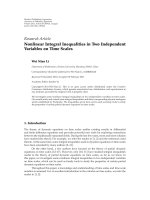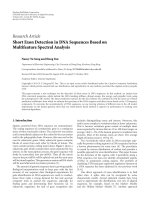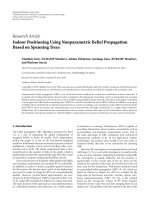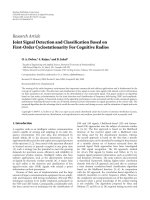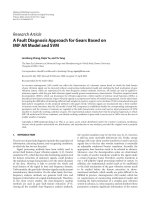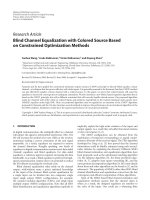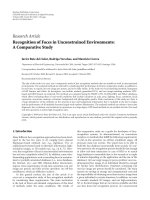Báo cáo hóa học: " Research Article Autonomous Robot Navigation in Human-Centered Environments Based on 3D Data Fusion" docx
Bạn đang xem bản rút gọn của tài liệu. Xem và tải ngay bản đầy đủ của tài liệu tại đây (7.46 MB, 10 trang )
Hindawi Publishing Corporation
EURASIP Journal on Advances in Signal Processing
Volume 2007, Article ID 86831, 10 pages
doi:10.1155/2007/86831
Research Article
Autonomous Robot Navigation in Human-Centered
Environments Based on 3D Data Fusion
Peter Steinhaus, Marcus Strand, and R
¨
udiger Dillmann
Institute for Computer Science and Engineering (CSE), University of Karlsruhe (TH), Haid-und-Neu-Straße 7,
76131 Karlsruhe, Germany
Received 1 December 2005; Revised 14 July 2006; Accepted 17 December 2006
Recommended by Ching-Yung Lin
Efficient navigation of mobile platforms in dynamic human-centered environments is still an open research topic. We have already
proposed an architecture (MEPHISTO) for a navigation system that is able to fulfill the main requirements of efficient navigation:
fast and reliable sensor processing, extensive global world modeling, and distributed path planning. Our architecture uses a dis-
tributed system of sensor processing, world modeling, and path planning units. In this arcticle, we present implemented methods
in the context of data fusion algorithms for 3D world modeling and real-time path planning. We also show results of the prototypic
application of the system at the museum ZKM (center for art and media) in Karlsruhe.
Copyright © 2007 Peter Steinhaus et al. This is an open access article distributed under the Creative Commons Attribution
License, which permits unrestricted use, distribution, and reproduction in any medium, provided the original work is properly
cited.
1. INTRODUCTION
The problem of navigating mobile systems in dynamic in-
door environments is one of the basic problems in the area of
mobile robots. Starting not long ago, as a first trend, service
robots and especially humanoid robots address more and
more human-centered working spaces, so the problem of ef-
ficient navigation in such dynamic scenarios seems to be very
important. As a second trend, sensor and computing tech-
nologies become cheaper, faster, and smaller, enabling the
design and implementation of huge sensor networks in the
so-called “intelligent buildings” (smart houses). As mobile
robots can also be seen as actuators of these intelligent build-
ings, it seems almost intuitive to combine both techniques,
mobile robots and sensor networks, to solve the problem of
efficient navigation in dynamic human-centered indoor en-
vironments.
Looking at the enormous amount of previous works al-
ready done in the field of navigation system research, almost
all approaches can be categorized with respect to their archi-
tectures in one of the following categories.
Autonomous onboard navigation
The problem of autonomous navigation without any help of
external sensor systems is addressed since the beginning of
mobile robotics. The used approaches can be divided into
the classes of functional/cybernetic, behavioristic, and hy-
brid approaches. A typical functional approach can, for ex-
ample, be found in [1, 2], where global and local planning
modules work on a 2D geometr ical and topological map to
plan subgoals for the mobile systems, using current sensor
data to adapt paths while targeting the subgoals. A behavior-
based approach is, for example, given in [3–5], where a set
of logical and physical sensor systems is situation-dependent
activated to search for edges or obstacles. A hybrid approach
which combines the functional deliberative aspects of path
planning with the reactive and behavioristic concepts of path
control can, for example, be found in [6]. Here, a coordi-
nation instance is used to activate the different behaviors
of the CAIR-2 robot system on an originally planned path.
The characteristic problem of all these approaches is that the
amount of environment information a mobile system can ac-
quire, at a specific point of time, is limited by the p erspectives
of the sensor systems, the sensor systems characteristics, and
situation-specific occlusions.
Autonomous multi-robot navigation
In multi robot environments (decoupled multi robot sys-
tems), it is possible to see every mobile system as a part of
a distributed sensor network consisting of several mobile
2 EURASIP Journal on Advances in Signal Processing
sensor agents. If these sensor agents are able to communi-
cate (e.g., if they are near enough together), they share their
current sensory data to achieve more complex environment
descriptions by sensor integration or fusion. Every robot
is working autonomously on its own environment model.
There is no central coordination unit. A typical implementa-
tion of this basic idea can be found in the CyberScout project
(see [7–9]), where 2D polygonal environment information is
distributed among the partners during environment explo-
ration processes.
There are some similar approaches that all share the same
main problem: in dynamic scenarios the mobile agents are
not able to generate a complete observation of the environ-
ment at every point of time, as they are moving around to
their own specific targets.
Smart-house navigation
The main idea of these approaches is to use an intelligent en-
vironment consisting of embedded distributed sensor net-
works in combination with centralized or also distributed
computing power to guide mobile systems in dynamic in-
door environments. The smart house can be responsible for
almost all navigation functionalities like localization, sensor
data acquisition, environment modeling, path planning or
collision avoidance. For example, in [10] a distributed cam-
era network is used in combination with a centralized com-
puting instance to build 2D obstacle maps for use by mobile
systems using the freespace approach. The scalability of this
approach to wide scenarios is limited due to the monolithic
system design. A similar approach using distributed intelli-
gent networked devices (DINDs) in a warehouse environ-
ment is examined in the Intelligent Space project (see [11–
13]), where a 2D environment/obstacle model is acquired by
cameras. The mobile robots are only equipped with odomet-
ric sensors. Most of the reviewed approaches use only 2D
models for environment representation instead of more real-
istic 3D models. Mobile sensor systems, as additional sensor
data sources, are not included.
Smart-house multi robot navigation
In this c ategory, additional mobile sensor systems are used
as an extension of the smart-house navigation concept to
improve the environment model degree of detail and help
in cases of occlusion. Here, stationary and mobile sensor
systems have to be fused to result in a global environment
model. There are just a few works in this area. One is in the
field of robot soccer (see [14–17]), where the soccer playing
robots share their sensor data with each other and a central
external instance. Another is in the approach of the intelli-
gent data carrier (IDC) (see [18–21]), where the external dis-
tributed components store regional environment informa-
tion that is gathered by mobile systems. Even here, only 2D
models are used for environment modeling.
We propose a navigation system approach belonging to
the smart-house multi robot navigation category, combining
stationary and mobile sensor sources to achieve a complete
3D environment model by fusing heterogeneous sensor data.
This environment model is used for real-time path planning
and path adaptation. In this article, we concentrate on the
homogeneous camera network processing, the data fusion
approach, and the resulting path planning method. Some re-
sults on data fusion of stationary and mobile sensors can be
found in [22].
Section 2 gives a short overview about the navigation sys-
tem architecture, Section 3 describes the methods used for
the stationary camera sensor network, Section 4 gives an in-
troduction to the data fusion algorithm, Section 5 shows the
theoretical background of the path planning and path adap-
tion processes and Section 6 demonstrates some experimen-
tal results.
2. NAVIGATION SYSTEM ARCHITECTURE
The navigation system architecture has the following charac-
teristics:
(i) use of a heterogeneous distributed sensor network
consisting of stationary and mobile components (scal-
ability, completeness);
(ii) stationary sensors build up a homogeneous color cam-
era network;
(iii) use of 3D laser range sensors as mobile sensors;
(iv) distributed sensing, environment modeling, data fu-
sion and, path planning;
(v) data fusion to 3D environment models;
(vi) hierarchical real-time path planning and path adapta-
tion approach.
We propose the use of specialized local-area processing
units (LAPUs). They perform the observation of their local-
area, the update of their local environment model, the short-
time prediction, and the short-way planning. Every LAPU is
connected to a robot control unit (RCU) that contacts the
robots via wireless ethernet to send commands and receive
status messages and preprocessed 2D and 3D sensor data.
The combination of the LAPUs with their dedicated RCUs is
called a global area processing unit (GAPU). Figure 1 shows
an example of a GAPU with 6 LAPUs and 2 RCUs.
For global and local path planning, environment model
enhancement, and sensor data fusion a neighborhood graph
of the observed areas gives the basic network topology of
our sensor network. Fast ethernet connections between LA-
PUs themselves and also to RCUs ensure the validity of inter-
changed sensor, path, and administ rative data.
Figure 2 shows the complex architecture of a LAPU. Be-
ginning in the sensor layer, the local sensor module (LSM)
tracks the positions of obstacles and robots during their way
through the sensor area. The resulting data is given to the
local environment modeling module (LEMM) and the lo-
cal environment prediction module (LEPM) in the environ-
ment layer. These build up the current- and short-time f u-
ture environment representations for the local area planning
module (LAPM) and the global planning module compo-
nent (GPMC) in the planning layer. The LEPM is responsible
for choosing a good path inside the local sensor area while
P eter Steinhaus et al. 3
RCU
RCU
LAPU
LAPU
LAPU
LAPU
LAPU
LAPU
Figure 1: Distributed structure of the navigation system.
LAPU
RCU
LCM
GAPMC LAPM
LEMM LEPM
LSM
Communication
Planning
Environment
modelling
Data acquisition
Figure 2: Components of a local area processing unit (LAPU).
the GPMC is planning a good path to the destination LAPU.
The local communication module (LCM) is responsible for
handling incoming and outgoing sensors, planning and ad-
ministrative data to the other LAPUs and the dedicated RCU.
More details about the architecture, their components
andthecommunicationbetweenmodulesaregivenin[23].
Figure 3 gives a simplified description of the data flow
between the different components of the navigation system
architecture. It can be seen that every sensor source results
in a single unique view on the global environment and that
these views are fused to the current dynamic 3D environment
model.
3. STATIONARY ENVIRONMENT VIEWS
In our setup, the LAPUs build a homogeneous sensor net-
work which is equipped with standard CCD color cameras.
These cameras are fixed to the ceiling of our laboratory and
result in different perspective views of the environment. As
the camera positions are stationary, difference image analysis
can be used to find obstacles in the image and to compute
the corresponding world-model representation. Color cam-
eras are used because the neon lights in the laboratory gener-
ate shadows that cannot be suppressed in gray images.
The difference-image algorithm works as follows: the
digitized color image is acquired in RGB format. The fi rst
step of the algorithm is to transform this RGB color space for-
mat image into HLS (hue, lightning, saturation) format. The
reference image is stored already in HLS. To suppress shad-
ows, the heuristic is that a current image pixel representing
the shadow of an object on the unchanged background has
approximately the same hue and saturation values as the cor-
responding pixel in the reference image. The light ning com-
ponent differs significantly. So the lightning component i s ig-
nored and two difference images (hue, saturation) are gener-
ated. Every difference image has to be processed by morpho-
logic opening and closing operations to fill gaps and elim-
inate isolated pixels. Therefore, for every difference image
two binarized images are generated (with a high and a low
threshold). The high threshold binary image does only hold
pixels that have to be in the resulting binary image, but has
many gaps in it. Therefore, it is processed by closing opera-
tions to fill these gaps. As not only the gaps get filled but the
blob area grows in all directions, an AND-operation with the
lower threshold binary image is computed to cut these areas.
At the end, we have binary images representing the differ-
ences in hue and saturation. These binary images are com-
bined by an OR-operation to get the resulting binary image.
On the binary image, a blob search is performed that re-
sults in the pixel contours of all obstacles in the camera area.
These pixel contours are transformed into polygons by an it-
erative end point fit algorithm to reduce the complexity of
the obstacle description. Using a special interpolation-based
camera calibration, the mapping from pixel coordinates to
world coordinates is done by a table look up in one step. The
latency introduced through is very low due to the distributed
approach. In world model coordinates, the contour polygons
of the obstacles can be used to construct a boundary surface
representation of every obstacle volume by knowing the posi-
tion of the camer a for every LAPU and building a view poly-
hedron for e very obstacle. These obstacle volume estimations
are transferred to the local environment model and to the
LAPUs topologic neighbors. A description of the maximal
possible view polyhedron of every camera sensor is also given
to every LAPU after the camera calibration process. Details
on the stationar y environment views can be found in [22].
4. FUSION OF VIEWS
The environment model is organized as a 3D surface model.
All objects are represented as set of triangles with corre-
sponding information about object number, center of grav-
ity, object trajectory, and so forth. The environment model
module receives the obstacle polyhedrons from the local sen-
sor layer, possibly from neighboring LAPUs sensor layers
and all mobile sensors in their area and has to integrate and
fuse these data to object representations. These polyhedrons
are in general not convex but as we ig nore the floor area
4 EURASIP Journal on Advances in Signal Processing
Combination of stationary and mobile sensors
Static
environment
Stationary
sensor
Stationary
sensor
Stationary
sensor
Paths
.
.
.
.
.
.
Local
views
Fusion of
views
Path planning/
adaptation
Dynamic
environment
model
Goal
Mortimer
Local
view
Self-
localization
Drive
control
Mobile
sensors
Figure 3: Simplified dataflow diagram.
every facet of the polyhedron is convex. Given overlapping
sensor areas of different LAPUs, it is possible to reconstruct
an approximation of the 3D scene by intersecting the differ-
ent view polyhedrons. This is done by converting the trian-
gle representation of the environment to a BSP tree (binary
space partitioning tree). At the beginning, the first object of
the first camera builds the root tree, then other objects of
the first camera extend this tree. This tree is used to inter-
sect the polyhedrons of another camera with the first cam-
era. As a result, a more complex BSP tree is again the starting
point for the next camera data fusion. When all polyhedrons
of all cameras belong to the tree, the remaining triangles of
the intersection can be read from the tree and give the cor-
responding environment model. As the fusion algorithm can
only work in the intersection volume of the view areas of all
cameras, an extension to the union volume has been imple-
mented. It is possible to extend the local object polyhedron
representation by a so-called neutral volume representation.
This neutral volume represents the volume given by the dif-
ference of the union of all view volumes and the view volume
of that specific camera.
The resulting triangle structure of the environment de-
scription is then analyzed with respect to triangle clusters to
identify objects, to track them permanently, and to give the
possibility of a short-time prediction of object paths.
The environment model data structure is called DU with
DU
=
f
i
, N
i
|
i = 1, , n
. (1)
Here every convex facet f
i
denotes a boundary representation
of the occupied space, N
i
is the corresponding normal vector
denoting the inside/outside relation of the facet. Details on
the fusion of views can be found in [22].
5. PATH PL ANNING
The path planning module supervises the platforms move-
ment to a specified goal point. Here, real time planning is
necessary to ensure the validity of the path at any time. Ad-
ditionaly, predictable narrow passages and dead ends should
be identified and avoided. Our proposed path planner fulfills
these requirements due to two properties.
(i) At every time step, the system provides either an effi-
cient path from the current robot’s pose to the goal or
the information that there is no valid path in the cur-
rent obstacle configuration.
(ii) The hierarchical system approach differentiates be-
tween global and local path planning tasks. Hereby, the
path planning task can be distributed over several LA-
PUs and parallel calculations are possible.
A LAPU can have several different tasks, depending on the
platforms position and goal.
Traversal
when traversing a LAPU a trajectory between two transfer
points, specified by the global path planner, has to be gener-
ated.
Entry
a path has to be generated from the transfer point to the goal
within the LAPU.
Exit
a path has to be generated from current location to the trans-
fer point of a neighboring LAPU.
P eter Steinhaus et al. 5
Internal drive
the local path planner generates a path between two points
within the LAPU.
In every case, a path between two specified points has to be
generated and maintained. The following theoretical notes
refer to path planning and adaption from any start to any
goal configuration.
First, the complex 3D environment model is reduced
for high-speed processing of the path planner. In a second
step, two parallel processes are initiated. In the main process,
an initial path planner determines a valid path within the
current environment configuration. This path is constantly
modified due to moving obstacles by means of a dynamic
path adaption. In parallel, another process tries permanently
to find an alternative path, which is significantly more effi-
cient than the current modified path.
5.1. Reduction of the environment model
The environment model consists of a 3D-occupied space
description DU with
DU
=
f
i
, N
i
|
i = 1, , n
. (2)
To transform the model for realtime path planning, several
steps are carried out.
(1) The robots geometry is removed from the environ-
ment representation. For planning a collision free
path, every obstacle for a mobile platform r has to be
considered. This means that, every robot geometry, ex-
cept the robot r,hastobeaddedtoDU so that
DUR
r
= DU
i,i=r
GM
i
. (3)
(2) In a next step, the environment model will be reduced
to the information, which is really necessary for p lat-
form navigation. Therefore the platform r is approxi-
mated by a cylindric bounding box, whose parameters
are determined in the platform geometries GM
r
.All
available information with z-coordinates bigger than
the height h of the bounding box can be discarded, so
that the resulting model is DUR
r
(h).
(3) For the detection of a collision between a facet of the
model and the bounding box of the platform, the re-
sulting 3D model is projected onto the plane z
= 0, so
that
PDU R
r
=
f
i
, N
i
| i = 1, , n, f
i
∈ R
2
, N
i
∈ R
2
.
(4)
(4) With a discretization of the LAPU area, collisions be-
tween the environment facets and the platform can
be calculated very fast. This late discretization helps
to keep the memory requirements low, since the dis-
cretization space is 2D and the discretization is re-
stricted to the local LAPU area. The environment grid
UG(x, y) has a value UG(x, y)
= 1 if the position is
occupied, so that
UG (x, y)
= 1 ⇐⇒ ∃ f ∈ PDU R
r
: INSIDE
(x , y), f
=
1, else UG (x, y) = 0.
(5)
The function INSIDE tests, if a coordinate lies within
a convex polygon.
5.2. Initial path planning
An initial path is determined with help of a wave propaga-
tion algorithm. In order to simplify calculations, the geom-
etry of the platform is ignored and the robot is viewed as
one single movable point. Therefore, the complete reduced
environment is distended with the amount of the platform
diameter, plus some extra space for safety reasons, so that the
results in both kinds of views coincide. On the beginning of
the quest for a feasible path, a simulated wave is sent from
the goal point, spreading in all directions. Only free space is
treated as propagation medium, so that waves are not allowed
to travel though obstacles. As the wave reaches the robots
position, the propagation finally stops and the existence of
a path is proved. Throughout the propagation, collision free
distance to the goal point is stored. This distance informa-
tion is considered as potential and an artificial potential field
is generated. By means of a gradient descent, a path from the
robot position to the goal point which bypasses obstacles is
determined (see Figure 4).
5.3. Dynamic path adaption
The generated path is permanently modified and adapted
due to moving obstacles. For this task, methods of the elastic
band developed by O. Khatib and S. Quinlan [24]areused.
This approach supposes the path can behave in changing en-
vironments like an elastic band. This means that the path is
repelled from approaching obstacles but contracts to remove
slack as an obstacle withdraws from the current path. The
elastic band is represented by bubbles of free space. The ra-
dius of a bubble is equivalent to the distance to the closest
object. This means that the platform always moves collision
free as long as it remains within a bubble. The path is covered
with subsequently overlapping bubbles with the center on the
path. Thus the collision free path is simply represented by the
corresponding set of bubbles with center and radius informa-
tion (see Figure 5).Thepathismodifiedbytheadaptionof
every bubble to the current environment configuration. In-
ternal and external forces apply to the center of each bubble.
The internal force removes originated slack and tightens the
band. The amount and direction of the internal force is only
depending on the position of the two neighbor ing bubbles,
which try to locate the enclosed bubble centric. The exter-
nal force repels the bubble from obstacles. The distance to
the obstacle determines the value of the external force so that
close objects result in a strong force. Both forces are weighed
and summarized. Each bubble obtains a new location and
thus the original path is modified. Finally, the new set of
bubbles is checked concerning the complete coverage of the
6 EURASIP Journal on Advances in Signal Processing
Goal
Start
40
60
80
100
120
180
160
140
120
100
Figure 4: Environment and start/goal configuration, generated artificial potential field, and resulting path.
Goal
Start
Figure 5: Overlapping bubbles represent the path.
Mortimer
Hotel K
¨
ubler
Figure 6: Mobile service robot MORTIMER.
path. If two bubbles do not overlap, an intermediate bubble
is generated. Bubbles which are redundant are removed from
the bubble set. The resulting bubble set describes the adapted
path and will be modified itself in the next time step.
5.4. Alternative paths
Situations may occur in which the current bubble set does
not describe the shortest path to a goal point. Imagine a
person walking into a tightened band amid the start and goal
points. The elastic band is repelled as long as the person keeps
on walking. At some point a path behind the person would
be much more reasonable but the bubbles still repel from the
moving obstacle and do not describe the shortest path to the
goal any more. To handle such cases, the initial path plan-
ning module calculates in a parallel thread about every two
seconds a path from the current robot position to the goal. If
this path is significantly more efficient than the current path,
this alternative path is used by the dynamic path adaption
module for further path modification.
6. EXPERIMENTS
Some data fusion and path planning experiments have been
performed in the entrance hall of the museum of art and
media technology (ZKM) in Karlsruhe. In our experimen-
tal implementation, there were four LAPUs equipped with
sensors and one combined LAPU/RCU for robot control, fu-
sion, path planning, and display. The pure LAPUs are imple-
mented as Matrox 4-Sight-II embedded PCs with 600 MHz
Pentium III processors, firewire interface, and 100 Mbit net-
work cards for communication. As sensors, Sony firewire
color cameras were used. The four-sensor systems observed
an area of approximately 120 qm. The combined LAPU/RCU
consisted of a dual processor PC with two Intel Pentium III
(933 MHz) processors, 100 Mbit network connection, and
additionally fast access to the wireless ethernet for robot con-
trol. All components of the advisory system run Windows
NT as operating system. As an experimental robot system
the service robot Mortimer (see Figure 6) has been used. Ba-
sic skills of Mortimer were odometric drive control, collision
avoidance, and laser-based repositioning. As the robots tasks
are real-time critical, we are using VxWorks as an operating
system to ensure the fulfillment of the real-time conditions.
The maximal velocity is about 1 m/s.
Figure 7 shows an image sequence of the entrance hall.
The detected object contours can be seen at about 10 frames
per second. In Figure 8, the integration of the computed view
polyhedrons of four LAPUs is demonstrated.
P eter Steinhaus et al. 7
(a) t = 0s (b) t = 2s (c) t = 4s
(d) t = 6s (e) t = 8s (f) t = 10 s
(g) t = 12 s (h) t = 14 s (i) t = 16 s
(j) t = 18 s (k) t = 20 s (l) t = 22 s
Figure 7: Object detection and contour polygons.
(a) t = 0s (b) t = 1s (c) t = 2s (d) t = 3s
Figure 8: Object polyeder integration.
Figure 9 shows a sequence of generated 3D models and
the corresponding situations in the entrance hall. This se-
quence is also reconstructed by four LAPUs with about 5
frames per second.
Figure 10 refers to a path planning experiment where a
path adaption process was performed between two fixed po-
sitions on the floor plane. The initial path planning method
gives a first solution to the problem and further on this
8 EURASIP Journal on Advances in Signal Processing
(a) t = 0s (b) t = 2s (c) t = 4s (d) t = 6s
(e) t = 8s (f) t = 10 s (g) t = 12 s (h) t = 14 s
Figure 9: Real scenes and corresponding 3D models.
(a) t = 0s (b) t = 1s (c) t = 2s (d) t = 3s
(e) t = 4s (f) t = 5s (g) t = 6s (h) t = 7s
(i) t = 8s (j) t = 9s (k) t = 10 s (l) t = 11 s
(m) t = 12 s (n) t = 13 s (o) t = 14 s (p) t = 15 s
Figure 10: 3D model and corresponding path planning experiment.
P eter Steinhaus et al. 9
solution is adapted by the elastic-band method. System per-
formance depends mainly on the number of bubbles and
hence on the number and distance of surrounding static and
dynamic obstacles. In the shown experiments, a path update
rate of about 8 Hz could be achieved.
7. CONCLUSION
Inthisarticle,wehavegivenanoverviewaboutournavi-
gation system approach. It consists of a distributed sensor
network in combination with distributed data fusion, envi-
ronment modeling, and path planning. Some first results of
mobile and stationary environment views fusion have been
shown. A first navigation experiment under real conditions
(museum hall) has been demonstrated. Further work will be
done in the fields of improving the image processing algo-
rithms, doing environment model analysis, predicting obsta-
cle behavior, and adapting path planning to the results of the
prediction process.
ACKNOWLEDGMENTS
This work has been partly suppor ted by the Deutsche
Forschungsgemeinschaft (DFG) in the Collaborative Re-
search Center 588 on Humanoid Robots and by the BMBF
project MORPHA (anthropomorphic assistance systems).
The authors would like to thank both institutions for their
support.
REFERENCES
[1] L. Kiss, A. R. V
´
arkonyi-K
´
oczy, and P. Baranyi, “Autonomous
navigation in a known dynamic environment,” in Proceedings
of the 12th IEEE International Conference on Fuzzy Systems,
vol. 1, pp. 266–271, St. Louis, Mo, USA, May 2003.
[2] L. Kiss and A. R. V
´
arkonyi-K
´
oczy,“Ahybridautonomous
robot navigation method based on artificial intelligence and
soft computing techniques,” in Proceedings of the IFAC Interna-
tional Conference on Intelligent Control Systems and Signal Pro-
cessing (ICONS ’03), pp. 251–256, Faro, Portugal, April 2003.
[3] H. Hu and J. M. Brady, “A bayesian approach to real-time ob-
stacle avoidance for an intelligent mobile robot,” Autonomous
Robots, vol. 1, no. 1, pp. 69–92, 1994.
[4] H. Hu, J. M. Brady, F. Du, and P. Probert, “Distributed real-
time control of a mobile robot,” The International Journal of
Intelligent Automation and Soft Computing,vol.1,no.1,pp.
68–83, 1995.
[5] H. Hu, D. Gu, and M. Brady, “Navigation and guidance of
an intelligent mobile robot,” in Proceedings of the 2nd Euromi-
cro Wor kshop on Advanced Mobile Robots (EUROBOT ’97),pp.
104–111, Brescia, Italy, October 1997.
[6] B S. Ryu and H. S. Yang, “Integration of reactive behaviors
and enhanced topological map for robust mobile robot nav-
igation,” IEEE Transactions on Systems, Man, and Cybernetics
Part A: Systems and Humans, vol. 29, no. 5, pp. 474–485, 1999.
[7] M. Saptharishi, C. S. Oliver, C. P. Diehl, et al., “Distributed
surveillance and reconnaissance using multiple autonomous
ATVs: CyberScout,” IEEE Transactions on Robotics and Au-
tomation, vol. 18, no. 5, pp. 826–836, 2002.
[8] A. Soto, M. Saptharishi, J. Dolan, A. Trebi-Ollennu, and P.
Khoshla, “Cyberatvs: dynamic and distributed reconnaissance
and surveillance using all-terrain UGVs,” in Proceedings of In-
ternational Conference on Field and Service Robotics, pp. 329–
334, Pittsburgh, Pa, USA, August 1999.
[9] C. P. Diehl, M. Saptharishi, J. B. Hampshire II, and P. K.
Khosla, “Collaborative surveillance using both fixed and mo-
bile unattended ground sensor platforms,” in Unattended
Ground Sensor Technologies and Applications, vol. 3713 of Pro-
ceedings of SPIE, pp. 178–185, Orlando, Fla, USA, April 1999.
[10] A. Hoover and B. D. Olsen, “Real-time occupancy map from
multiple video streams,” in Proceedings of IEEE International
Conference on Robotics and Automation (ICRA ’99), vol. 3, pp.
2261–2266, Detroit, Mich, USA, May 1999.
[11] J H. Lee, N. Ando, T. Yakushi, K. Nakajima, T. Kagoshima,
and H. Hashimoto, “Applying intelligent space to ware-
house—the first step of intelligent space project,” in Proceed-
ings of IEEE/ASME International Conference on Advanced In-
telligent Mechatronics (AIM ’01), vol. 1, pp. 290–295, Como,
Italy, July 2001.
[12] J H. Lee and H. Hashimoto, “Controlling mobile robots in
distributed intelligent sensor network,” IEEE Transactions on
Industrial Electronics, vol. 50, no. 5, pp. 890–902, 2003.
[13] K. Morioka, J H. Lee, and H. Hashimoto, “Human-following
mobile robot in a distributed intelligent sensor network,” IEEE
Transactions on Industrial Electronics, vol. 51, no. 1, pp. 229–
237, 2004.
[14] T. Weigel, “Roboter-fußball: selbstlokalisierung, weltmodel-
lierung, pfadplanung und verhaltensbasierte kontrolle,” M.S.
thesis, Institut f
¨
ur Informatik, Albert-Ludwigs-Universitt
Freiburg, Freiburg, Germany, 1999.
[15] T. Weigel, J S. Gutmann, M. Dietl, A. Kleiner, and B. Nebel,
“CS Freiburg: coordinating robots for successful soccer play-
ing,” IEEE Transactions on Robotics and Automation, vol. 18,
no. 5, pp. 685–699, 2002.
[16] J S. Gutmann, W. Hatzack, I. Herrmann, et al., “The CS
Freiburg robotic soccer team: reliable self-localization, multi-
robot sensor integration and basic soccer skills,” in RoboCup-
98: Root Soccer World Cup II, M. Asada and H. Kitano, Eds.,
Lecture Notes in Artificial Intelligence, pp. 93–108, Springer,
Berlin, Germany, 1999.
[17] B. Nebel, J S. Guttmann, and W. Hatzack, “The CS Freiburg
’99 team,” in RoboCup-99: Robot Soccer World Cup III,Lecture
Notes in Artificial Intelligence, pp. 703–706, Springer, Berlin,
Germany, 2000.
[18] T. Fujii, H. Asama, T. Fujita, et al., “Knowledge sharing among
multiple autonomous mobile robots through indirect com-
munication using intelligent data carriers,” in Proceedings of
the IEEE/RSJ International Conference on Intelligent Robots
andSystems(IROS’96), vol. 3, pp. 1466–1471, Osaka, Japan,
November 1996.
[19] T. Fujii, H. Asama, T. Fujita, H. Kaetsu, A. Matsumoto, and I.
Endo, “Intelligent data carrier system for cooperative behav-
iors emerged among collective robots,” in Proceedings of the
IEEE International Conference on Systems, Man and Cybernet-
ics, vol. 1, pp. 299–304, Orlando, Fla, USA, October 1997.
[20] Y. Arai, T. Fujii, H. Asama, H. Kaetsu, and I. Endo, “Realiza-
tion of autonomous navigation in multirobot environment,”
in Proceedings of the IEEE/RSJ International Conference on In-
telligent Robots and Systems (IROS ’98), vol. 3, pp. 1999–2004,
Victoria, Canada, October 1998.
[21] D. Kurabayashi and H. Asama, “Knowledge sharing and co-
operation of autonomous robots by intelligent data carrier
system,” in Proceedings of IEEE International Conference on
Robotics and Automation (ICRA ’00), vol. 1, pp. 464–469, San
Francisco, Calif, USA, April 2000.
10 EURASIP Journal on Advances in Signal Processing
[22] P. Steinhaus, M. Walther, B. Giesler, and R. Dillmann, “3D
global and mobile sensor data fusion for mobile platform nav-
igation,” in Proceedings of IEEE International Conference on
Robotics and Automation (ICRA ’04), vol. 4, pp. 3325–3330,
New Orleans, La, USA, May 2004.
[23] P. Steinhaus, M. Ehrenmann, and R. Dillmann, “Eine skalier-
bare, verteilte Architektur zur Navigation mobiler Systeme in
dynamischen Umgebungen,” in Autonome Mobile Systeme,pp.
11–18, Karlsruhe, Germany, November-December 1998.
[24] S. Quinlan and O. Khatib, “Elastic bands: connecting path
planning and control,” in IEEE International Conference on
Robotics and Automation, vol. 2, pp. 802–807, GA, USA, May
1993.
Peter Steinhaus received his Dipl Inform.
degree in computer science from the Uni-
versity of Karlsruhe (TH), Germany, in
1997. He is currently a Research Assis-
tant at the Institute for Computer Science
and Engineering at University of Karlsruhe
(TH), Germany, and he coordinates the
German Collaborative Research Center on
Humanoid Robots.
Marcus Strand received his Dipl Ing. de-
gree in electrical engineering from the Uni-
versity of Karlsruhe (TH), Germany, in
2002. He is currently a Research Assistant at
the Institute for Computer Science and En-
gineering at University of Karlsruhe (TH),
Germany, and he is currently working in the
field of autonomous 3D mapping and sen-
sor fusion.
R
¨
udiger Dillmann received his Dipl Ing.
degree in electrical engineering and his
Ph.D. degree from the University of Karl-
sruhe (TH), Germany, in 1976 and 1980,
respectively. He is currently a Full Profes-
sor in the Department of Computer Sci-
ence at the University of Karlsruhe ( TH),
Germany. His research interests include hu-
manoid robotics, programming by demon-
stration and medical simulation systems.
He is the head of the German Collaborative Research Center on
Humanoid Robots in Karlsruhe.
